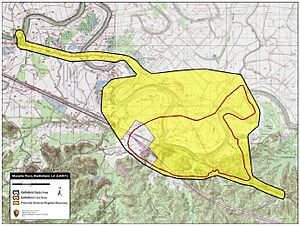Battle of Monett's Ferry facts for kids
Quick facts for kids Battle of Monett's Ferry |
|||||||
|---|---|---|---|---|---|---|---|
| Part of the Trans-Mississippi Theater of the American Civil War |
|||||||
|
|||||||
| Belligerents | |||||||
| Commanders and leaders | |||||||
| Nathaniel P. Banks | Hamilton P. Bee | ||||||
| Units involved | |||||||
| US Army Department of the Gulf, Red River Expeditionary Force XIII Corps, XIX Corps, Elements of the XVI Corps and XVII Corps from the Army of the Tennessee. plus additional troops | Bee's Cavalry Division: Major’s, Bagby’s, Debray’s, and Terrell’s brigades of cavalry and McMahan’s, Moseley’s, J. A. A. West’s, and Nettles’ batteries | ||||||
| Strength | |||||||
| 25,000 to 30,000 | 2500 to 3000 | ||||||
| Casualties and losses | |||||||
| 200 | 400 | ||||||
The Battle of Monett's Ferry happened on April 23, 1864. It was a fight during the Red River Campaign of the American Civil War. Union soldiers, led by Nathaniel P. Banks, fought against Confederate forces. The Union troops won by crossing a river and making the Confederates retreat.
Why the Battle Happened
This battle took place near the end of the Red River Expedition. Major General Nathaniel P. Banks was leading the Union army. His army was leaving Grand Ecore in Natchitoches Parish, Louisiana. They were moving back to Alexandria. Confederate forces were following them closely.
How the Battle Unfolded
On the morning of April 23, Union troops reached Monett's Ferry. This spot was also known as Cane River Crossing. Brigadier General William H. Emory led the Union's advance group. They met Confederate cavalry led by Brigadier General Hamilton P. Bee.
General Bee had orders to stop the Union army from crossing the river. He placed his soldiers in a strong position. Natural features on both sides protected his troops. General Emory did not want to attack such a strong defense directly. So, he made a show of force in front of the Confederate lines. The 47th Pennsylvania Infantry Regiment was among the Union troops helping Emory. This was the only regiment from Pennsylvania in the 1864 Red River Campaign.
While Emory kept the Confederates busy, two other Union brigades looked for another way to cross. One brigade successfully found a shallow spot, called a ford. They crossed the river there. Then, they attacked the Confederates from the side. This surprise attack forced General Bee's troops to retreat.
After the Confederates left, Banks's men quickly built pontoon bridges. These are temporary bridges made of floating sections. By the next day, all of the Union soldiers had crossed the river.
What Happened After the Battle
The Confederates at Monett's Ferry missed a chance to defeat or capture Banks's army. General Richard Taylor believed General Bee made several mistakes. He thought Bee should not have sent some regiments away. He also felt Bee did not make his position stronger with earthworks.
Taylor also believed Bee put too many troops in the middle. He thought Bee should have focused on his flanks, or sides. Finally, Taylor said Bee retreated too far. Bee moved his entire force 30 miles back. Taylor thought Bee should have attacked the Union column, which was disorganized.
However, General Hamilton P. Bee had his reasons. His horses and men were tired from constant fighting. They had been fighting since the Battle of Mansfield on April 8, 1864. Bee's forces were also outnumbered by about 10 to 1. They were almost out of supplies and ammunition.
Bee wrote that he chose to save his force. He wanted to fight another day. He did not want his entire force to be surrounded and destroyed. He believed it was an impossible task. Saving his troops meant avoiding a needless loss of soldiers that could not be replaced. People have debated who was to blame for the Confederate defeat ever since.


